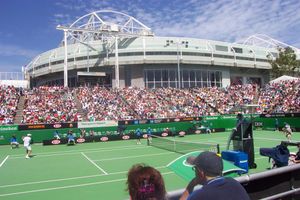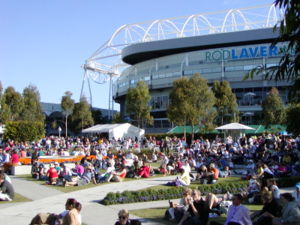Australian Open
2008/9 Schools Wikipedia Selection. Related subjects: Sports events
| Australian Open | ||
|---|---|---|
 |
||
| Grand Slam | ||
| Location | Melbourne |
|
| Venue | Melbourne Park | |
| Surface | Plexicushion | |
| Men's Draw | 128S / 128Q / 64D | |
| Women's Draw | 128S / 96Q / 64D | |
| Prize Money | AU$20,600,000 | |
| Official website | ||
| Grand Slam tournaments | ||
|
||
The Australian Open is the first of the four Grand Slam tennis tournaments to be held each year. It is held each January at Melbourne Park. The tournament was held for the first time in 1905. Like the other three Grand Slam events, it was contested by top-ranked amateur players and known as the Australian Championships until the advent of open era in 1968. Originally based at the grass courts at Kooyong in the city of Melbourne's inner south-east, the tournament was in danger of fading into irrelevance before being revived in 1988 with a shift to Melbourne Park (then called Flinders Park), a new ( Rebound Ace) hardcourt venue next to the Melbourne Cricket Ground on the southern fringe of the central business district. Mats Wilander was the only player to win the tournament both on grass and on Rebound Ace.
Like all the Grand Slam tournaments, there are men's and women's singles competitions, men's, women's, and mixed doubles, as well as junior and master's competitions.
The Australian Open was held in December from 1977 through to 1985, returning to its original January date in 1987. In 1986, because of the return to January, no tournament was held.
The two main courts used in the tournament are Rod Laver Arena and Vodafone Arena and feature retractable roofs, which can be shut in case of rain or extreme heat. It is the only Grand Slam tournament that features indoor play. However, work has already commenced on a retractable roof for Wimbledon's Centre Court, which is expected to be completed by 2009.
Held in the middle of the Australian summer, the Australian Open is famous for its notoriously hot days. An extreme-heat policy is often put into play when temperatures (and humidity) reach dangerous levels.
The Australian Open typically has very high attendance, with the 2008 Australian Open achieving the highest ever day/night attendance record for any Grand Slam tournament of 62,885.
In 2008, the Rebound Ace surface, which had been in place for the past 20 years at Melbourne Park, was replaced by a cushioned acrylic surface known as Plexicushion. The main benefits of the new surface: better consistency and less retention of heat (due to a thinner top layer). This change was accompanied by changes in the surfaces of all lead-up tournaments to the Australian Open. Work began on the removal of the old surface on 4 June 2007. The decision has been met with much controversy, primarily due to the new surface's similarity to DecoTurf, the surface already being utilised by the US Open.
History
The Australian Open is managed by Tennis Australia, formerly the Lawn Tennis Association of Australia (LTAA), and was first played at the Warehouseman's Cricket Ground in St Kilda Road, Melbourne in 1905.
The tournament was first played in 1905 as The Australasian Championships, became the Australian Championships in 1927 and the Australian Open in 1969. Since 1905, the Australian Open has been staged in five different cities as follows: Melbourne (50 times), Sydney (17 times), Adelaide (14 times), Brisbane (8 times), Perth (3 times), as well as in New Zealand, (2 times) in 1906 Christchurch and 1912 Hastings. In 1972 it was decided to stage the tournament in the same city each year, the Kooyong Lawn Tennis Club was selected due to Melbourne attracting the biggest patronage.
Melbourne Park (formerly Flinders Park) was constructed in time for the 1988 Open to meet the demands of the evolving tournament that had outgrown Kooyong's capacity. The move to Melbourne Park was an immediate success, with a 90 per cent increase in attendance in 1988 (266,436) on the previous year at Kooyong (140,000).
Because of its geographic remoteness very few foreign players entered this tournament at the beginning. (In the 1920s it took about 45 days to make the trip by ship from Europe to Australia.) The first tennis players who came by aircraft were the US Davis Cup players in November 1946. Even inside the country many players couldn't travel easily; when the Championships were held in Perth, no Victorians or New South Welshers crossed by train, a distance of approximately 3,000 kilometres between the east and west coasts. And even a Melburnian often didn't play the Championships when held in Sydney. In 1906, in Christchurch, New Zealand, of a small field of 10 players, only two Australians attended.
The first tournaments of the Australasian Championships suffered from the competition of the other Australasian tournaments, and before 1905 all of the Australian states and New Zealand had their own championships, the first being organised in 1880 in Melbourne and called the Championship of the Colony of Victoria (later become the Championship of Victoria).
From 1969, when the first Australian Open was held, on the Milton Courts at Brisbane, the tournament was open to all players—including professionals, who weren't allowed to play the traditional circuit. Nevertheless, except for the 1969 and 1971 tournaments, many of the best players missed this championship until 1982, because of the remoteness, the wrong dates (Christmas and New Year's Day), and the low prize money — in 1970 the National Tennis League (NTL), which employed Rod Laver, Ken Rosewall, Andres Gimeno, Pancho Gonzales, Roy Emerson and Fred Stolle, prevented its players from entering the tournament because the guarantees were insufficient, and the tournament was ultimately won by Arthur Ashe.
In 1983, Ivan Lendl and John McEnroe came Down Under and Mats Wilander, having to play the Davis Cup final in the same site as the Australian Open's ( Kooyong stadium in Melbourne) a few days after the tournament, decided at the last moment to enter the Australian championship in order to be ready and fit for the Cup. (It succeeded beyond all hope because the Swede won the tournament and his two Davis Cup singles.) From that year the Australian Open began to deserve its 'Grand Slam' label. Nevertheless the International Tennis Federation prompted the Lawn Tennis Association of Australia to change the site of the tournament, because the Kooyong stadium was then inappropriate to serve such a big event, and in 1988 the tournament was first held at Flinders Park (later renamed Melbourne Park) on Rebound Ace a rubber surface laid over concrete. Since 1995, the year when Andre Agassi entered the competition for the first time, no great players have missed this tournament unless injured or suspended. The Australian Open has therefore become one of the four biggest tennis competitions.
Before the Melbourne Park stadium era, tournament dates fluctuated as well, in particular in the early years because of the climate of each site or exceptional events. For example, just after World War I, the 1919 tournament was held in January 1920 (the 1920 tournament was played in March); the 1923 tournament in Brisbane took place in August when the weather is not too hot and wet. After a first 1977 tournament was held in December 1976 – January 1977, the organisers chose to move the next tournament forward a few days, then a second 1977 tournament was played (ended on 31 December) but this failed to attract the best players. From 1982 to 1985 the tournament was played in mid-December, then it was decided to move the next tournament to mid-January (January 1987), thus there was no tournament in 1986. Since 1987 the Australian Open date has not changed.
Recent attendances
- 2008 - 605,735
- 2007 - 554,858
- 2006 - 550,550
- 2005 - 543,873
- 2004 - 521,691
Trophies and prize money
Names of the winners are inscribed on the perpetual trophy Cups.
- The Women's Singles winner is presented with the Daphne Akhurst Memorial Cup.
- The Men's Singles winner is presented with the Norman Brookes Challenge Cup.
In 2008 the prize money awarded in the Men's and Women's singles tournaments was equal and distributed as follows:
- 1st Round: A$19,400
- 2nd Round: A$30,250
- 3rd Round: A$50,000
- 4th Round: A$85,625
- Quarter finalist: A$171,250
- Semi finalist: A$342,500
- Runners-up: A$685,000
- Winners: A$1,370,000 (US$1,197,739.20)
Records
| Record | Open Era | Player(s) | Count | Years |
|---|---|---|---|---|
| Gentlemen's Singles since 1905 | ||||
| Winner of most Gentlemen's Singles titles | Before 1968: | 6 | 1961, 1963-67 | |
| 4 | 1931-33, 1935 1953, 1955, 1971-72 |
|||
| After 1968: | 4 | 1995, 2000-01, 2003 | ||
| 3 | 1983-84, 1988 2004, 2006-07 |
|||
| Winner of most consecutive Gentlemen's Singles titles | Before 1968: | 5 | 1963-67 | |
| After 1968: | 2 | 1971-72 1978-79 1981-82 1983-84 1985-87 1989-90 1992-93 2000-01 2006-07 |
||
| Winner of most Gentlemen's Doubles titles | Before 1968: | 8 | 1938-40, 1946-50 | |
| 5 | 1965, 1967, 1971, 1976 - 1973 John Newcombe with Mal Anderson, 1976 (December) Tony Roche with Arthur Ashe | |||
| After 1968: | 4 | 1980-81 (with Kim Warwick), 1983 (with Paul McNamee) 1984 (with Sherwood Stewart) | ||
| 3 | see above 1978 (with Wojtek Fibak), 1980-81 1992, 1996 (with Mark Woodforde, 2001 (with Jonas Björkman) |
|||
| Winner of most consecutive Gentlemen's Doubles titles | Before 1968: | 8 | 1938-40, 1946-50 | |
| After 1968: | 2 | 1980-81 1983 (with Paul McNamee), 1984 (with Sherwood Stewart), 1988-89 2003-04 2006-07 |
||
| Winner of most Mixed Doubles titles - Gentlemen | Before 1968: | 4 | 1963, 1965-66, 1968 (with Nancye Wynne Bolton) | |
| After 1968: | 4 | 1940, 1946-1948 (with Billie Jean King) | ||
| Winner of most Championships (total: singles, doubles, mixed) - Gentlemen | Before 1968: | 11 | 1929-1935 (4 singles, 4 doubles, 3 mixed) | |
| After 1968: | 5 | 1988-90 (2 doubles, 3 mixed) | ||
| Ladies's Singles since 1922 | ||||
| Winner of most Ladies' Singles titles | Before 1968: | 11 | 1960-66, 1969-71, 1973 | |
| 6 | 1937, 1940, 1946-48, 1951 | |||
| After 1968: | 4 | 1969-71, 1973 1974-76, 1977 1988-90, 1994 1991-93, 1996 |
||
| Winner of most consecutive Ladies' Singles titles | Before 1968: | 7 | 1960-66 | |
| After 1968: | 3 | 1969-71 1974-76 1988-90 1991-93 1997-99 |
||
| Winner of most Ladies' Doubles titles | Before 1968: | 13 | 1936-40, 1947-49, 1951-52 (with Nancye Wynne Bolton), 1954, 1956, 1958 (with Mary Bevis Hawton) | |
| 10 | 1936-40, 1947-49, 1951-52 | |||
| After 1968: | 8 | 1980 (with Betsy Nagelsen), 1982-85, 1987-89 (with Pam Shriver) | ||
| Winner of most consecutive Ladies' Doubles titles | Before 1968: | 5 | 1936-40 | |
| After 1968: | 7 | 1982-85, 1987-89 | ||
| Winner of most Mixed Doubles titles - ladies | Before 1968: | 4 | 1924-25 (with John Willard), 1928 (with Jean Borotra), 1929 (with Gar Moon) 1940, 1946-48 (with Colin Long)
|
|
| After 1968: | 2 | 1988-89 (with Jim Pugh) 1994 (with Andrei Olhovskiy), 1996 (with Mark Woodforde) |
||
| Winner of most Championships (total: singles, doubles, mixed) - ladies | Before 1968: | 22 | 1960-1973 (11 singles, 7 doubles, 4 mixed) | |
| After 1968: | 12 | 1981-2003 (3 singles, 8 doubles, 1 mixed) | ||
Champions
Main articles listed by event:
- Men's Singles
- Women's Singles
- Men's Doubles
- Women's Doubles
- Mixed Doubles

